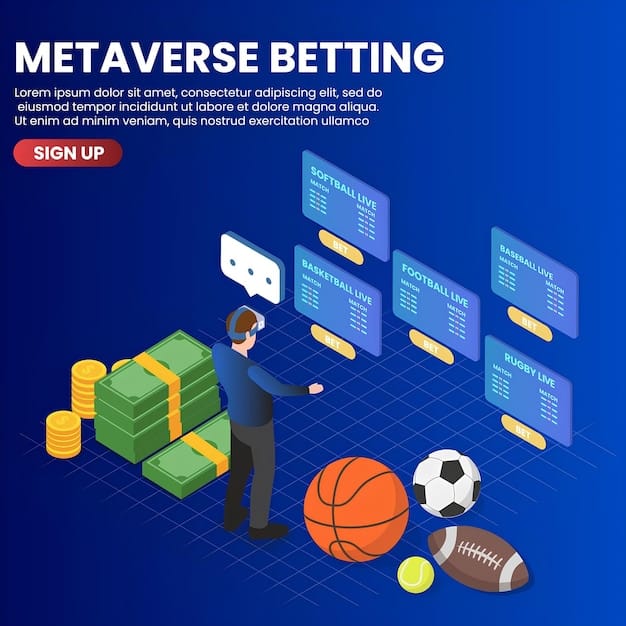Esports Tournament Prize Pools 2025: Maximize Your ROI

When considering Esports Tournament Prize Pools: Which Games Offer the Highest ROI in 2025?, titles like Dota 2, League of Legends, CS2, and battle royales consistently provide the most substantial returns, driven by massive fan engagement, publisher backing, and consistent competitive circuits.
As the esports industry continues its meteoric rise, understanding where the biggest financial opportunities lie is crucial for players, organizations, and investors alike. The landscape of Esports Tournament Prize Pools: Which Games Offer the Highest ROI in 2025? is constantly evolving, with new titles emerging and established giants solidifying their dominance. This article delves into the games projected to offer the most significant returns in the competitive gaming scene for the upcoming year.
The evolving landscape of esports prize pools
The competitive gaming world has seen an unprecedented surge in popularity and financial investment over the past decade. Prize pools, once modest, now regularly reach multi-million dollar figures, transforming esports into a legitimate career path for many. This growth is fueled by a combination of dedicated fan bases, massive viewership numbers, and significant support from game publishers and corporate sponsors. Understanding these dynamics is essential for predicting which games will continue to lead in financial opportunities.
The structure of prize pools themselves varies dramatically across different titles and circuits. Some games, like Dota 2, rely heavily on crowdfunding initiatives where a percentage of in-game purchases directly contributes to the prize pool, allowing it to swell to astronomical sums. Others, such as League of Legends, maintain more fixed, publisher-funded prize structures, prioritizing consistency and long-term sustainability for their professional ecosystems. Both models have proven successful in creating lucrative environments for players.
Understanding the metrics of ROI in esports
When we discuss “Return on Investment” (ROI) in esports, it’s not solely about the total prize money. It encompasses several factors that contribute to a game’s long-term viability and attractiveness for professional players. These include not just the size of individual tournament payouts but also:
- Prize pool distribution: How many teams or players share the wealth? A massive prize pool that only rewards the top-ranked team might offer less ROI for the broader professional scene than one which distributes funds more widely.
- Tournament frequency: Are there consistent opportunities to compete and earn throughout the year? A game with a robust seasonal league and multiple major tournaments offers more sustained income potential than one with a single, annual blockbuster event.
- Sponsorship opportunities: Beyond direct prize money, a game’s popularity directly translates into endorsement deals, streaming revenue, and team sponsorships, which often far exceed tournament earnings.
These elements collectively paint a more complete picture of a game’s financial health and its potential ROI for those involved. A game might not always boast the absolute highest single prize pool, but its overall ecosystem could offer a better and more stable return throughout the year.
The esports ecosystem in 2025 is expected to be more mature, with publishers continually refining their competitive structures. This refinement aims to strike a balance between sensational, large-scale events and consistent, accessible avenues for professional play, ensuring that talent can thrive at various levels. The ongoing investment in grassroots scenes also plays a crucial role, creating a pipeline for future stars and sustaining interest in the competitive integrity of the games.
Dota 2: The undisputed king of crowdfunding
Dota 2 has consistently set the benchmark for esports prize pools, primarily thanks to its innovative crowdfunding model tied to The International (TI). This annual flagship tournament regularly boasts prize pools exceeding tens of millions of dollars, making it one of the most lucrative events in all of competitive gaming. The unique approach allows fans to directly contribute to the prize money through in-game purchases, fostering an unparalleled sense of community engagement and investment in the competitive scene.
The international’s ongoing legacy
The International is not just a tournament; it’s a global spectacle that captivates millions. Valve’s commitment to enhancing the TI experience, coupled with continued community support for the Battle Pass (or similar seasonal offerings), ensures that its prize pool remains astronomical. While the sheer scale of TI might overshadow other tournaments in terms of individual payouts, the consistent high-stakes competition throughout the DPC (Dota Pro Circuit) provides ample opportunities for professional teams to earn.
- Crowdfunding model: A significant percentage of sales from seasonal Battle Passes directly fuels The International’s prize pool. This organic growth strategy has proven incredibly effective.
- Global fanbase: Dota 2 boasts a dedicated and global player base, ensuring consistent viewership and enthusiastic participation in crowdfunding efforts.
- Consistent competitive circuit: Beyond TI, the Dota Pro Circuit (DPC) features regional leagues and major tournaments, offering year-round competition and income streams for top teams.
The strategic timing of The International, usually in late summer or early fall, provides a clear culmination point for the competitive year, building anticipation and drawing immense attention. The consistent presence of storied organizations and legendary players also adds to the narrative depth, keeping fans engaged year after year.
As 2025 approaches, Dota 2 is expected to maintain its position at the pinnacle of prize pool value. Valve’s sustained development of the game, alongside the loyal community, suggests that The International will continue to break records. The game’s complex mechanics and high skill ceiling also ensure a compelling viewing experience, drawing new fans while retaining veterans. This blend of player investment and viewer entertainment is a powerful combination for financial success.
League of legends: A structured pathway to prosperity
League of Legends, published by Riot Games, approaches its prize pools with a more structured and centralized philosophy. While individual tournament prize pools might not always reach the dizzying heights of Dota 2’s International, the sheer volume, consistency, and global reach of its competitive ecosystem ensure a high and reliable ROI for professional players and organizations. Riot’s commitment to nurturing a stable competitive environment is unmatched.
Global leagues and robust earnings
Riot Games operates a multi-tiered system of regional leagues, such as the LCS (North America), LEC (Europe), LCK (Korea), and LPL (China), culminating in the Mid-Season Invitational (MSI) and the World Championship. These leagues offer fixed salaries for players, consistent competitive schedules, and substantial prize pools at their peak international events. This structured approach provides a clear career path and financial stability rare in other esports.
- Publisher-backed stability: Riot Games directly funds a significant portion of prize pools and player salaries, creating a more predictable financial environment.
- Global franchised leagues: The franchise model in major regions ensures long-term team stability and consistent income for organizations, attracting significant external investment.
- Massive viewership: League of Legends consistently breaks viewership records for its major international tournaments, attracting lucrative sponsorship deals.
The strategic franchising of its premier leagues has allowed teams to build foundational businesses around their esports operations, cultivating local fan bases and securing major brand partnerships. This stability trickles down to players, who benefit from steady employment contracts in addition to prize money.
Looking ahead to 2025, League of Legends is poised for continued growth. Riot Games has shown a consistent willingness to innovate within its esports structure, adapting to new trends while maintaining the integrity of its competitive play. The game’s enduring popularity and its strong presence in key global markets suggest that its ROI for players and teams will remain exceptionally high, driven by a combination of prize money, salaries, and robust sponsorship opportunities.
Counter-Strike 2: The continued legacy of tactical shooting
The transition from CS:GO to Counter-Strike 2 (CS2) marked a significant evolution for one of esports’ most enduring titles. While the game’s core tactical shooter mechanics remain, the updated engine and visual enhancements have revitalized interest and are expected to drive prize pools higher in 2025. CS2’s ROI comes from its consistent tournament circuit, community engagement, and a highly skilled player base.
Major tournaments and community support
CS2 maintains a vibrant independent tournament circuit, with events hosted by various organizers like ESL, BLAST, and others, culminating in Valve-sponsored Majors. These Majors are the pinnacle of CS2 competition and offer substantial prize pools, though traditionally not reaching Dota 2’s crowdfunded extremes. The community’s deep engagement, particularly with in-game cosmetic markets, indirectly supports the scene by driving continued player interest and publisher investment.
- Established independent circuit: A mature ecosystem of third-party tournament organizers ensures a packed competitive schedule year-round.
- High skill ceiling: CS2’s demanding gameplay creates a compelling viewing experience and fosters a dedicated, passionate player base.
- Active skin market: The successful in-game cosmetic economy indirectly supports the game’s competitive longevity and appeal.
The cultural significance of Counter-Strike in esports cannot be overstated. It has been a cornerstone of competitive gaming for over two decades, building a loyal following that transcends generations. The continuous stream of high-level tournaments, often with regional qualifiers and international stages, provides a constant pipeline of fresh talent and engaging storylines.
In 2025, CS2 is anticipated to further consolidate its position as a top-tier esport. Valve’s ongoing stewardship, combined with the competitive drive of its professional players and the robust support from tournament organizers, points to a stable and growing ecosystem. The high stakes and tactical depth make every match a nail-biter, guaranteeing continuous viewership and, consequently, healthy prize pools and sponsorship deals.
Battle royales: Fortunes in fast-paced combat
Battle royale games, characterized by their large-scale, last-player-standing format, have exploded in popularity and carved out a significant niche in esports prize pools. Titles like Fortnite, PUBG, and Apex Legends have hosted tournaments with multi-million dollar payouts, attracting a massive audience and a dedicated professional scene. Their ROI in 2025 is expected to remain strong due to broad audience appeal and continuous content updates.
Fortnite, pubg, and apex legends’ competitive edge
Fortnite, with its unique building mechanics and accessible appeal, has famously offered some of the largest prize pools in esports history, notably the Fortnite World Cup. PUBG maintains a strong global presence, especially in Asia, with significant yearly championships. Apex Legends has rapidly grown its competitive circuit with consistent developer support and a thriving streaming scene. Each game leverages its strengths to attract and reward top-tier players.
- Massive player bases: The sheer number of casual players translates into a vast potential audience for competitive events.
- Publisher investment: Dedicated esports initiatives from Epic Games (Fortnite), Krafton (PUBG), and EA/Respawn (Apex Legends) ensure robust prize support.
- Dynamic gameplay: The unpredictable nature of battle royales makes for thrilling viewing and keeps audiences engaged.
The episodic nature of many battle royale games, with seasons introducing new maps, weapons, and characters, also keeps the competitive meta fresh and exciting. This constant evolution prevents stagnation and provides new challenges for professional players, ensuring long-term engagement from both competitors and viewers.
For 2025, battle royale esports are likely to continue their impressive run. Publishers are increasingly sophisticated in developing competitive formats that showcase skill while retaining the entertainment value of the genre. The accessibility of many battle royale titles also means a lower barrier to entry for aspiring pros, fostering a dynamic talent pool that keeps the competitive scene vibrant and financially rewarding.
Emerging titles and dark horses for 2025 ROI
While established giants like Dota 2 and League of Legends are expected to dominate prize pools, the esports landscape is constantly evolving, with new games emerging that could offer significant ROI in 2025. Keeping an eye on these “dark horses” is crucial for those hoping to identify the next big opportunity before it fully breaks out. These titles often benefit from innovative gameplay, strong publisher backing, or a rapidly growing community.
Valorant’s ascent and other potential contenders
Valorant, Riot Games’ tactical shooter, has already established itself as a major esport, leveraging Riot’s expertise in building competitive ecosystems. It boasts a global circuit and significant prize pools, and its growth trajectory suggests it could challenge the established giants. Beyond Valorant, other games could surprise.
- Valorant: With Riot Games’ proven track record, Valorant’s structured league system and ever-growing global fanbase position it for sustained high ROI. Expect significant prize pool growth.
- New releases: Keep an eye on any major AAA releases in 2024-2025 that announce dedicated esports plans. Strong publisher support early on can quickly elevate a game’s competitive scene.
- Mobile esports: Games like Mobile Legends: Bang Bang and PUBG Mobile already command massive prize pools, especially in Asia. This sector is projected for continued explosive growth globally.
The strategic investment from publishers in their competitive scenes is a strong indicator of future ROI. Games with clear, long-term esports roadmaps and consistent content updates are more likely to attract and retain professional talent and viewership. This stability is a key component for financial success.
As we move into 2025, diversification within the esports portfolio might be a wise strategy. While investing in the proven top-tier games offers reliable returns, identifying and supporting promising emerging titles could yield even greater long-term dividends. The dynamic nature of the industry ensures that there’s always a new frontier for competitive excellence and financial opportunity.
Factors influencing future prize pool growth
Predicting the future of esports prize pools involves understanding several key factors that drive their growth and sustainability. These elements collectively shape the financial health of the competitive gaming industry and dictate which games will continue to offer the highest ROI in 2025 and beyond. From viewer engagement to technological advancements, each plays a pivotal role.
Technology, viewership, and sponsorship drivers
Technological advancements, particularly in streaming platforms and virtual reality, could open new avenues for viewer engagement and monetization, directly impacting prize pool potential. The continued globalization of esports means tapping into new markets with vast fan bases, further increasing viewership and, consequently, sponsorship desirability.
- Viewer engagement: The size and dedication of a game’s viewership directly translate into ad revenue and sponsorship appeal, which often fund prize pools.
- Sponsorships and partnerships: Major non-endemic brands are increasingly investing in esports, bringing significant financial backing to tournaments and teams.
- Platform innovation: Advances in streaming, interactivity, and even virtual reality could create new revenue streams and enhance the esports viewing experience, raising prize ceilings.
The increasing acceptance of esports as mainstream entertainment is also a critical factor. As more people recognize competitive gaming’s legitimacy and appeal, it attracts broader investment and larger audiences, creating a virtuous cycle of growth. This mainstream acceptance helps shed old stigmas and allows the financial potential to be fully realized.
In 2025, the synergy between these factors will be more pronounced. Games that effectively leverage technological trends, cultivate global communities, and attract diverse sponsorship portfolios will be those that offer the most compelling ROI. The industry’s ability to adapt and innovate will be crucial for maintaining its impressive growth trajectory and continuing to elevate the competitive stakes.
| Key Game | ROI Factor |
|---|---|
| 💰 Dota 2 | Crowdfunded prize pools at The International remain unparalleled. |
| 🛡️ League of Legends | Structured leagues, publisher backing, and global reach for stable earnings. |
| 🔫 Counter-Strike 2 | Consistent independent circuit and Major tournaments attract significant capital. |
| 🎮 Battle Royales | Massive player bases and publisher investment drive large prize pools. |
Frequently Asked Questions About Esports Prize Pools
Dota 2 consistently holds the record for the largest prize pools, primarily due to its crowdfunding model for The International. This event often accumulates tens of millions of dollars, making it the most lucrative single tournament in esports year after year.
ROI, or Return on Investment, in esports prize pools refers to the overall financial benefit for players and organizations. This includes not just the raw prize money, but also income from regular league play, sponsorship opportunities, and the potential for long-term career stability in a particular game.
While crowdfunded prize pools, like Dota 2’s, generate astronomical sums, publisher-funded models (e.g., League of Legends) are more common for providing consistent, large-scale support across global league systems. Many top-tier esports utilize a hybrid approach to maximize funds.
Sponsorships are critically important, often comprising a significant portion of a professional player’s and team’s income. Beyond tournament prize money, deals with brands for endorsements, gear, and team backing provide crucial financial stability and can even exceed prize earnings for top-tier talent.
Mobile esports prize pools, particularly in Asia, are already massive and growing rapidly. While they may not universally surpass PC esports by 2025, titles like Mobile Legends: Bang Bang and PUBG Mobile are closing the gap, demonstrating incredible ROI for their respective professional scenes and attracting huge audiences.
Conclusion
The esports industry in 2025 promises to be a dynamic and lucrative arena for players, teams, and investors. While games like Dota 2, League of Legends, and Counter-Strike 2 are set to maintain their dominance with substantial prize pools and robust ecosystems, the continued growth of battle royales and the rapid ascent of titles like Valorant suggest a healthy diversification of opportunities. Understanding the intricate balance between direct prize money, consistent league play, and the omnipresent influence of sponsorships is key to identifying where the highest ROI truly lies. As the sector matures, careful strategic planning and an eye for emerging trends will be paramount for capitalizing on the financial potential of competitive gaming.







